#King Hezekia
Text
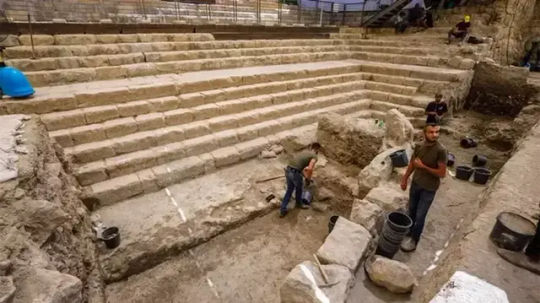
Biblical Steps Where Jesus 'Healed a Blind Man' Unearthed by Archaeologists
In Jerusalem, a recent excavation effort uncovered stairs that had been hidden for more than 2,000 years near the spot where the New Testament says Jesus treated a blind man.
A new excavation project in Jerusalem has unearthed steps unseen in over 2,000 years at a place where the New Testament records Jesus as having healed a blind man.
The Israel Antiquities Authority, the Israel National Parks Authority and the City of David Foundation early this year announced that the Pool of Siloam, a biblical site cherished by Christians and Jews, will be open to the public for the first time in 2,000 years in the near future.
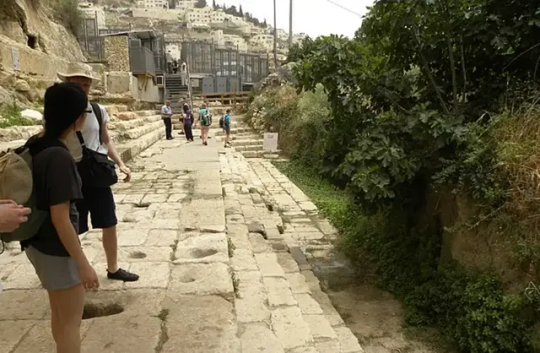
In recent weeks, archeologists achieved significant progress in the excavation, unearthing some eight steps descending into the Pool which had not been seen in 2,000 years — around the time when Jesus walked the Earth.
“The ongoing excavations within the City of David — the historic site of Biblical Jerusalem — particularly of the Pool of Siloam and the Pilgrimage Road, serve as one of the greatest affirmations of that heritage and the millennia-old bond Jews and Christians have with Jerusalem,” Ze’ev Orenstein, director of International Affairs – City of David Foundation said.
“Not simply as a matter of faith, but as a matter of fact,” he added.
The City of David Foundation is a non-profit organization established in 1986, “dedicated to the preservation and development of the City of David and its environs, and is committed to connecting people of all faiths and backgrounds to ancient Jerusalem.”

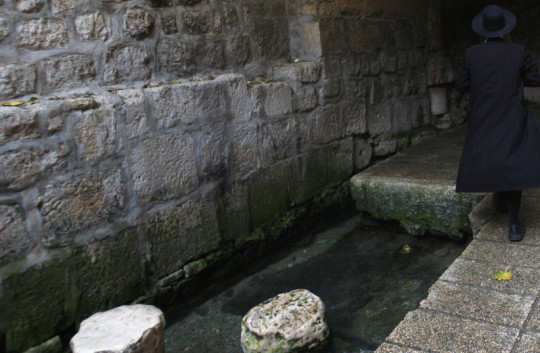

“The half-mile running through the City of David, from the Pool of Siloam in the south, continuing along the Pilgrimage Road, up to the footsteps of the Western Wall, Southern Steps and Temple Mount, represents the most significant half-mile on the planet,” Orenstein said.
“There is no half-mile anywhere on Earth which means more to more people – not to millions, but to billions — than the half-mile that is the City of David,” he added.
The pool was first built roughly 2,700 years ago as part of Jerusalem’s water system in the eighth century B.C.
The construction unfolded during the reign of King Hezekia as cited in the Bible in the Book of Kings II, 20:20, according to the two Israeli agencies and the City of David Foundation.
According to estimates, the Pool of Siloam passed through many stages of construction and reached the size of 1.25 acres.
According to a passage in the Gospel of John, Jesus restored the sight of a man born blind at the Pool of Siloam.
A small section of the pool, which has been fully excavated, has been accessible to the public for several years.
The vast majority of the pool is being excavated and will either be opened piecemeal or once the entire site is unearthed.

Rev. Johnnie Moore, president of the Congress of Christian Leaders, told Fox News Digital in January that, “In the Pool of Siloam, we find evidence of history preserved for us, revealed at just the right time.”
“Theologically, it affirms Scripture, geographically it affirms scripture, and politically it affirms Israel’s unquestionable and unrivaled link to Jerusalem. Some discoveries are theoretical. This one is an undeniable. It is proof of the story of the Bible and of its people, Israel,” he said.
A stroke of luck revealed the pool in 2004, when infrastructure work carried out by the Hagihon water company uncovered some of the pool’s steps.
The Israel Antiquities Authority, under supervision of professors Roni Reich and Eli Shukron, launched a survey.
As a result, the northern perimeter, as well as a small section of the eastern perimeter of the Pool of Siloam, were uncovered.
“Whether in the halls of the United Nations, ongoing efforts by Palestinian leadership, or on university campuses, Jerusalem’s Biblical heritage is under assault,” said Orenstein.
Orenstein noted that in few years time, visitors to the City of David will be able to witness the factual history for themselves and “see with their own eyes, touch with their own hands, and walk with their own feet upon the very stones their ancestors walked thousands of years ago, as they made their way to Jerusalem on pilgrimage.”
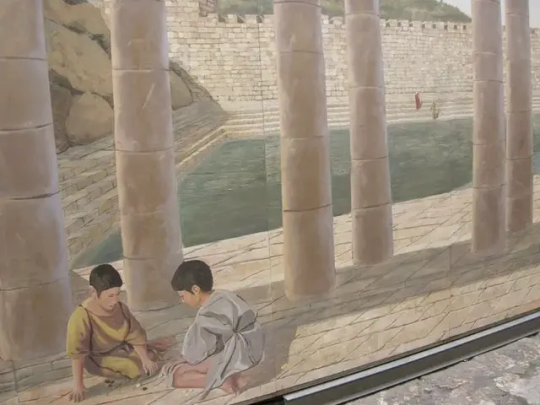

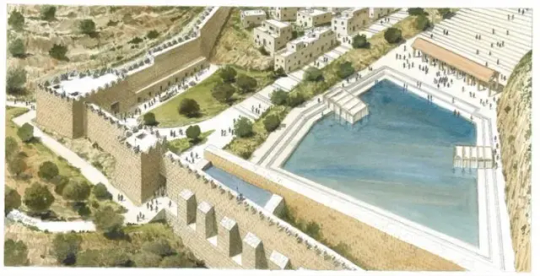
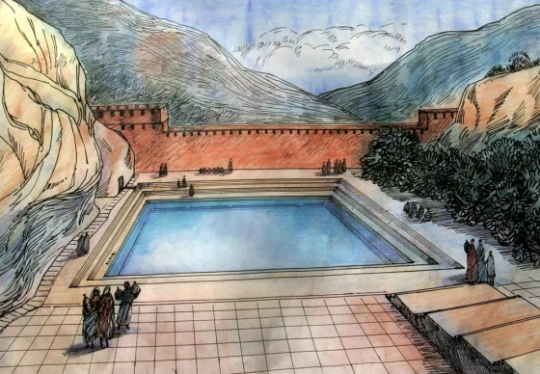
#Biblical Steps Where Jesus 'Healed a Blind Man' Unearthed by Archaeologists#Jerusalem#Israel#City of David#Pool of Siloam#Pilgrimage Road#King Hezekia#Jesus#Jesus Christ#ancient artifacts#archeology#archeolgst#history#history news#ancient history#ancient culture#ancient civilizations#ancient israel
130 notes
·
View notes
Text
Matthew 1:10
Ἑζεκίας δὲ ἐγέννησεν τὸν Μανασσῆ, Μανασσῆς δὲ ἐγέννησεν τὸν Ἀμώς, Ἀμὼς δὲ ἐγέννησεν τὸν Ἰωσίαν,
and Hezekias begat Manassēs, and Manassēs begat Amōs, and Amōs begat Iōsias,
Notes:
For more on ἐγέννησεν ("begat") and the definite article with names, see notes to Matthew 1:2.
~~~
For more on Ἑζεκίας, see notes to Matthew 1:9.
~~~
Μανασσῆς, transliterated here Manassēs (Manasseh), is son and successor to Hezekiah in the Old Testament. For his biography, see 2 Kings 21:1-18 and 2 Chronicles 33:1-20.
~~~
Ἀμώς, transliterated here Amōs (Amon), is son and successor to Manasseh in the Old Testament. For his biography, see 2 Kings 21:18-25 and 2 Chronicles 33:20-23.
~~~
Ἰωσίας, transliterated here Iōsias (Josiah), is son and successor to Amon in the Old Testament. For his biography, see 2 Kings 22-23 and 2 Chronicles 34-35.
0 notes
Text
Steps Where Jesus walked Healed a Blind Man Unearthed In Jerusalem
AMAZING!: Steps where Jesus walked and healed a blind man unearthed for first time in 2,000 years
A new excavation project in Jerusalem has unearthed steps unseen in over 2,000 years at a place where the New Testament records Jesus as having healed a blind man.
The Israel Antiquities Authority, the Israel National Parks Authority and the City of David Foundation early this year announced that the Pool of Siloam, a biblical site cherished by Christians and Jews, will be open to the public for the first time in 2,000 years in the near future.
In recent weeks, archeologists achieved significant progress in the excavation, unearthing some eight steps descending into the Pool which had not been seen in 2,000 years — around the time when Jesus walked the earth.
The ongoing excavations within the City of David , the historic site of Biblical Jerusalem, particularly of the Pool of Siloam and the Pilgrimage Road, serve as one of the greatest affirmations of that heritage and the millennia-old bond Jews and Christians have with Jerusalem," Ze’ev Orenstein, director of International Affairs - City of David Foundation, told Fox News Digital.
Not simply as a matter of faith, but as a matter of fact," he added.
The City of David Foundation is a non-profit organization established in 1986, "dedicated to the preservation and development of the City of David and its environs, and is committed to connecting people of all faiths and backgrounds to ancient Jerusalem."
"The half-mile running through the City of David, from the Pool of Siloam in the south, continuing along the Pilgrimage Road, up to the footsteps of the Western Wall, Southern Steps and Temple Mount, represents the most significant half-mile on the planet," Orenstein said.
"There is no half-mile anywhere on Earth which means more to more people not to millions, but to billions — than the half-mile that is the City of David," he added.
According to estimates, the Pool of Siloam passed through many stages of construction and reached the size of 1.25 acres. (City of David Foundation)
The pool was first built roughly 2,700 years ago as part of Jerusalem's water system in the eighth century B.C.
The construction unfolded during the reign of King Hezekia as cited in the Bible in the Book of Kings II, 20:20, according to the two Israeli agencies and the City of David Foundation.
According to estimates, the Pool of Siloam passed through many stages of construction and reached the size of 1.25 acres. According to a passage in the Gospel of John, Jesus restored the sight of a man born blind at the Pool of Siloam.
A small section of the pool, which has been fully excavated, has been accessible to the public for several years. The vast majority of the pool is being excavated and will either be opened piecemeal or once the entire site is unearthed.
Rev. Johnnie Moore, president of the Congress of Christian Leaders, told Fox News Digital ,
"In the Pool of Siloam, we find evidence of history preserved for us, revealed at just the right time."
"Theologically, it affirms Scripture, geographically it affirms scripture, and politically it affirms Israel’s unquestionable and unrivaled link to Jerusalem. Some discoveries are theoretical. This one is an undeniable. It is proof of the story of the Bible and of its people, Israel," he said.
A stroke of luck revealed the pool in 2004, when infrastructure work carried out by the Hagihon water company uncovered some of the pool’s steps. The Israel Antiquities Authority, under supervision of professors Roni Reich and Eli Shukron, launched a survey. As a result, the northern perimeter, as well as a small section of the eastern perimeter of the Pool of Siloam, were uncovered.
"Whether in the halls of the United Nations, ongoing efforts by Palestinian leadership, or on university campuses, Jerusalem's Biblical heritage is under assault," said Orenstein.
Orenstein noted that in few years' time, visitors to the City of David will be able to witness the factual history for themselves and "see with their own eyes, touch with their own hands, and walk with their own feet upon the very stones their ancestors walked thousands of years ago, as they made their way to Jerusalem on pilgrimage."
Read the full article
0 notes
Text
Company of the Dead Dreadnought #3: Ancient Hezekia
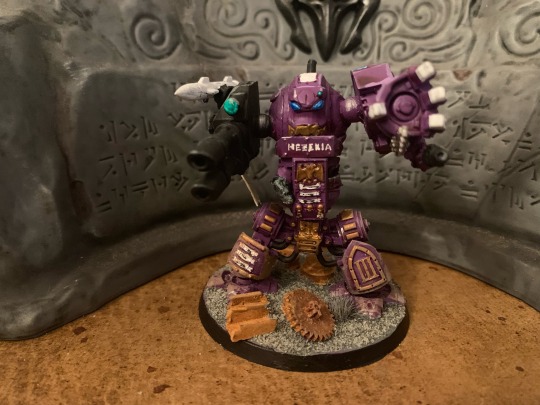

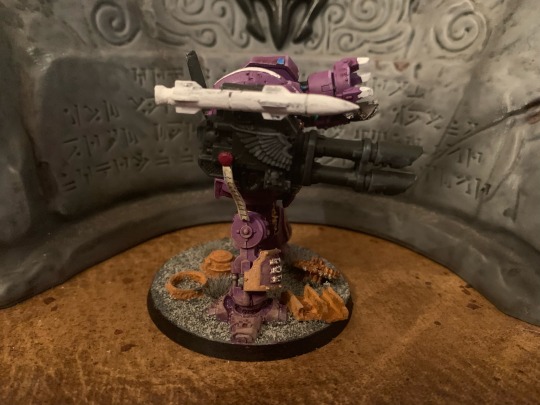
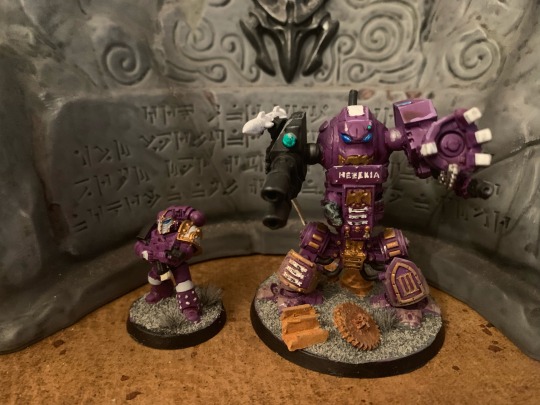
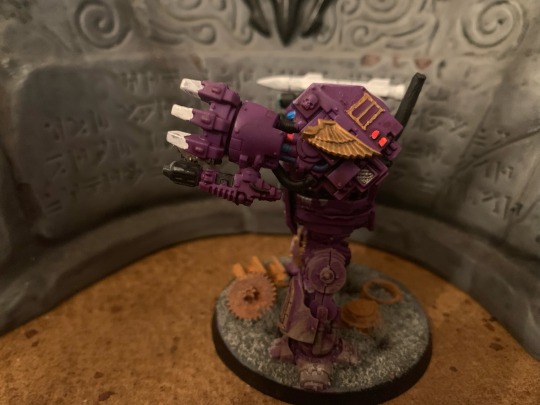
Born as Ibrahim Gelt, Hezekia was part of the first generation of Chemos born Astartes. As the son of an Archaeotech scavenger, Hezekia developed a love for machines and was eager to serve with the Legion’s armored formations. Indeed, Hezekia’s high marksmanship rating might well have seen his career take a different path but for his persistence.
Assigned to 9th Company’s motor pool, Hezekia spent a great deal of his career driving or navigating RH1N0 pattern transports before a promotion to command of the Sicaran Venator tank destroyer “Hekate.” When he was not engaged in his duties, Hezekia had an enduring love for “obsolete” or extinct musical instruments, and restored or fabricated several, learning to play each. Upon his interrment, he had gathered a small but rather valuable collection, which was subsequently bequeathed to the Terran Archives.
At Kadda-Ran entering his second decade with Hekate, Ibrahim Gelt was a part in one of III’s largest tank battles before the Heresy, engaged with Aeldari tanks and armored vehicles that had achieved parity in numbers with the Astartes. Despite significant losses, the Emperor’s Children managed to win the multi-day battle, losing two fifths of their armored vehicles in the process. Gelt was among those lost on the third day of fighting, accounting for four Eldar tanks and one Walker prior to somewhat ironically losing Hekate and her crew to a xenos tank destroyer. Crushed by the wreckage and severely burned, Gelt was interred and his stasis coffin installed within the chassis of a Contemptor. He served with honor for many decades with the honorific “Hezekia” in memory of a an ancient Habiru king.
At Isstvan III, Hezekia’s career nearly ended. His dreadnought drop pod, part of the first wave, was downed by Istvaanian defense batteries and could not open its doors. There he might have suffered a second death if not for the actions of another dreadnought - Venerable Sarpedon - in a tale for another entry. He was evacuated with the hard bitten loyalist survivors under Crysos Morturg.
The damage to Hezekia’s chassis was considerable, and he was transferred to what was at hand: a Contemptor-Proteus chassis. With the Company of the Dead, he most commonly mounts twin linked lascannon, power fist, and hunter killer missile.
Hezekia is an odd conversion, but people seem to like him. He was built from a damaged Rogue Trader era Contemptor Dreadnought, and pieces of two different Castaferrum models from a bargain bin. The etched brass, as usual, is FW. Although easily the size of a contemptor, I usually run him as a standard box-naught, though he did so well for me in our last engagement that this may change.
5 notes
·
View notes
Text
Christians do not believe in kismet, in fate
Christians do not believe in kismet, in fate
FOR CONSIDERATION

Christians do not believe in kismet, in fate. Though God determines the chief lines of our life, He is willing by our prayers and works, to change them. Thus, He prolonged King Hezekias’s life by fifteen years (Is. 38), and our holy father Dios (July 19th) also had his life lengthened by a similar period. God extended the life of St. Basil the Great by one day, at the saint’s…
View On WordPress
15 notes
·
View notes
Text
12/19/2019 DAB Transcript
Zephaniah 1:1-3:20, Revelation 10:1-11, Psalms 138:1-8, Proverbs 30:11-14
Today is the 19th day of December. Welcome to the Daily Audio Bible. I am Brian. It is great to be here with you today as we as we come around this Global Campfire, come in out of all the festivities and all of the activities and…and even out of all the chaos that can be this time of year and just take our place around this warm fire that's glowing in this oasis, this place and we can step away from it all for just a few minutes and allow God to reorient us so that we go back out into the world with our perspective rearranged. So, it is great to be here with you for that next step and we kinda have a little tradition as we move through December of moving quickly through all a lot of books, like reading entire books of the Bible in a single sitting, especially as we move to the minor prophets in the Old Testament. And, so, today is no different. we’ll read an entire book. It's called Zephaniah
Introduction to the book of Zephaniah:
It's the ninth of the minor prophets and as with the other minor prophets, we don't know much about Zephaniah. The book itself gives us the most substantial information that we have and that's in the first verse, “the Lord gave this message to Zephaniah when Josiah, son of Oman was king of Judah. Zephaniah was the son of Cushi, the grandson of Gedaliah, and the great-grandson of Amariah, son of Hezekia. So, what’s interesting about that description is that Zephaniah traced his ancestry four generations back instead of just naming his father, which would be customary. So, it’s not sure but that maybe because Zephaniah was a descendent of…of the godly and reforming King Hezekiah. And if that was the case, that would explain how it is that Zephaniah is so aware of the world that’s surrounding him as he speaks in this book. And if he was a descendent of a King, of King Hezekiah, then obviously his writing would've been given credibility and would've been paid attention. Zephaniah's name means God has hidden. And he says that he received this message during the reign of Josiah. And that would put him in the early to mid-600s B.C. which would put him in the same time period as other prophets like Jeremiah. Many biblical scholars believe that Zephaniah, because of the writing style, was familiar with the writings of…of other prophets like Isaiah because the language and the tone is similar. Many of the prophecies that we have been reading, they’re targeted specifically at certain people and certain groups, whereas Zephaniah seems to…seems to be offering a prophetic work that talks about the judgment of the entire known world, which included Judah. And Zephaniah was…was sharing that God's judgment, His judgment on evil was eminent and he describes that as the day of the Lord, which is…which is central in this book. So, Zephaniah's warning of the day of the Lord and encouraging a response and that response his repentance before it's too late. And this idea…I mean…and we’re kinda getting some of this imagery in Revelation as well. This idea of the day of the Lord of this ultimate judgment can certainly breed hysteria, can certainly evoke all kinds of ominous imagery of the kind of devastation upon the earth that we can't even imagine. So, it can make us fearful. It can make us dread the future. But we need to remember what God was after. What God is ultimately doing here is eradicating evil not eradicating people. But that requires collaboration. Anyone that wasn't willing to rid themselves of evil would be swept away no matter where they came from or no matter what claim they had, but certain people would survive, certain people would live through it, people who embodied a specific posture. And Zephaniah's speaks of that, “those who are left will be the lowly and humble. It's they who trust in the name of the Lord.” So, we’ve read enough prophetic work, prophetic writings in the Scriptures to kinda understand that there…there is an arc to them, there is a prophetic utterance of judgment but that also brings the heralding of a new beginning, a pure new beginning and Zephaniah's no different. So, judgment is foretold, but restoration is foretold and that’s almost across-the-board in prophecy. I mean, we lose sight of that pretty quickly, often because we get lost in…in the foretelling of judgment, but there is also the foretelling of restoration. So, let’s find comfort in that as we read in its entirety the book of Zephaniah which contains three chapters. And we’re reading from the God's Word Translation this week.
Prayer:
Father, we thank You for Your word. We thank You for another day in the rhythm of life that is each and every day in Your word as we move through a year. So, we thank You that on this day we were able to encounter an entire book, Zephaniah. And we thank You Father that, although yes, we can read of the ominousness, we also see that there are…there are always alternative paths, it doesn't have to go that way. And this is so true of our own lives. It doesn't have to go that way. There is an alternative path a narrow one, the one that leaves…leads to life. And we have been asking all year for You to lead us on that path and we thank You for Your faithfulness to us. And, so, as we and our time today, Father, Psalm 138 say what we need to say. And, so, we pray this together. We give thanks to You Father with all our hearts. We’ll make music to praise You in front of the all God's. We will bow toward You. We will give thanks to Your name because of Your mercy and truth. You have made Your name and Your promise greater than everything. When we called You answered us, You made us bold by strengthening our souls. All the kings of the earth will give thanks to You, oh Lord, because they have heard the promises You spoke. They will sing this about the ways of the Lord, the Lords honor is great. Even though You are high above us Lord, You see the humble close-up, and You recognize arrogant people from a distance. Even though we walk into the middle of trouble You guard our lives against the anger of our enemies. You stretch out Your hand and Your right hand saves us. You will do everything for us. Lord, Your mercy endures forever. Do not let go of what Your hands have made. And Father we reach for You with that assurance and we go into this day with that confidence. Come Holy Spirit we pray, in the name of Jesus we ask. Amen.
Announcements:
dailyaudiobible.com is home base and that's where you find out what’s going on around here.
It's been Christmas. It’s been Christmas for a while around here, Christmas time. It has been Christmastime everywhere. Can you believe that we are less than a week from Christmas day? So, I it's almost time for our annual Christmas party our virtual Christmas party where we called in all those calls. We’re getting that together, hopefully, hopefully this weekend maybe Monday at the latest. Just in time for the festivities of the holidays. So, we’re getting that together and that'll be fun...it's always fun. It’s always made…it's already made me cry. Just hearing…just…you'll see…you'll see. And, so, it's just so heartwarming, such a heartwarming thing, our annual Christmas party. It’s one of my favorite things that we do as a community in the year. So, watch out for that. That'll be coming soon.
If you want to partner with the Daily Audio Bible here in these last days of the year, thank you profoundly, humbly, with…with a full heart. Thank you for your partnership. So, there's a link on the homepage. If you're using the Daily Audio Bible app you can press the Give button in the upper-right hand corner or, if you prefer, the mailing address is PO Box 1996 Spring Hill Tennessee 37174.
And, as always, if you have a prayer request or comment you can hit the Hotline button in the app, the little red button at the top or you can dial 877-942-4253.
And that is it for today. I’m Brian I love you and I'll be waiting for you here tomorrow.
0 notes
Text
Want to know the history behind the Feast of the Epiphany?
New Post has been published on https://pray-unceasingly.com/catholic-living/catholic-news/want-to-know-the-history-behind-the-feast-of-the-epiphany/
Want to know the history behind the Feast of the Epiphany?
Washington D.C., Jan 6, 2019 / 01:01 pm (CNA/EWTN News).- While the hustle and bustle of Christmas ends for many people on Dec. 26, throughout Christian history Christmas lasts for twelve days – all the way until Jan. 6.
This feast marking the end of Christmas is called “Epiphany.”
In the Latin Rite of the Catholic Church, Epiphany celebrates the revelation that Jesus was the Son of God. It focuses primarily on this revelation to the Three Wise Men, but also in his baptism in the Jordan and at the wedding at Cana.
In the Eastern rites of the Catholic Church, Theophany – as Epiphany is known in the East – commemorates the manifestation of Jesus' divinity at his Baptism in the River Jordan.
While the traditional date for the feast is Jan. 6, in the United States the celebration of Epiphany is moved to the next Sunday, overlapping with the rest of the Western Church’s celebration of the Baptism of Christ.
However, the meaning of the feast goes deeper than just the bringing of presents or the end of Christmas, says Fr. Hezekias Carnazzo, a Melkite Catholic priest and founding executive director of the Virginia-based Institute of Catholic Culture.
“You can't understand the Nativity without Theophany; or you can’t understand Nativity without Epiphany.” The revelation of Christ as the Son of God – both as an infant and at his baptism – illuminate the mysteries of the Christmas season, he said.
“Our human nature is blinded because of sin and we’re unable to see as God sees,” he told CNA. “God reveals to us the revelation of what’s going on.”
Origins of Epiphany
While the Western celebration of Epiphany (which comes from Greek, meaning “revelation from above”), and the Eastern celebration of Theophany (meaning “revelation of God”), have developed their own traditions and liturgical significances, these feasts share more than the same day.
“The Feast of Epiphany, or the Feast of Theophany, is a very, very early feast,” said Fr. Carnazzo. “It predates the celebration of Christmas on the 25th.”
In the early Church, Christians, particularly those in the East, celebrated the advent of Christ on Jan. 6 by commemorating Nativity, Visitation of the Magi, Baptism of Christ and the Wedding of Cana all in one feast of the Epiphany. By the fourth century, both Christmas and Epiphany had been set as separate feasts in some dioceses. At the Council of Tours in 567, the Church set both Christmas day and Epiphany as feast days on the Dec. 25 and Jan. 6, respectively, and named the twelve days between the feasts as the Christmas season.
Over time, the Western Church separated the remaining feasts into their own celebrations, leaving the celebration of the Epiphany to commemorate primarily the Visitation of the Magi to see the newborn Christ on Jan. 6. Meanwhile, the Eastern Churches' celebration of Theophany celebrates Christ’s baptism and is one of the holiest feast days of the liturgical calendar.
Roman Traditions
The celebration of the visitation of the Magi – whom the Bible describes as learned wise men from the East – has developed its own distinct traditions throughout the Roman Church.
As part of the liturgy of the Epiphany, it is traditional to proclaim the date of Easter and other moveable feast days to the faithful – formally reminding the Church of the importance of Easter and the resurrection to both the liturgical year and to the faith.
Other cultural traditions have also arisen around the feast. Dr. Matthew Bunson, EWTN Senior Contributor, told CNA about the “rich cultural traditions” in Spain, France, Ireland and elsewhere that form an integral part of the Christmas season for those cultures.
In Italy, La Befana brings sweets and presents to children not on Christmas, but on Epiphany. Children in many parts of Latin America, the Philippines, Portugal, and Spain also receive their presents on “Three Kings Day.”
Meanwhile, in Ireland, Catholics celebrate “Women's Christmas” – where women rest from housework and cleaning and celebrate together with a special meal. Epiphany in Poland is marked by taking chalk – along with gold, incense and amber – to be blessed at Mass. Back at home, families will inscribe the first part of the year, followed by the letters, “K+M+B+” and then the last numbers of the year on top of every door in the house.
The letters, Bunson explained, stand for the names traditionally given to the wise men – Casper, Melchior and Balthazar – as well as for the Latin phrase “Christus mansionem benedicat,” or, “Christ, bless this house.”
In nearly every part of the world, Catholics celebrate Epiphany with a Kings Cake: a sweet cake that sometimes contains an object like a figurine or a lone nut. In some locations lucky recipient of this prize either gets special treatment for the day, or they must then hold a party at the close of the traditional Epiphany season on Feb. 2.
These celebrations, Bunson said, point to the family-centered nature of the feast day and of its original celebration with the Holy Family. The traditions also point to what is known – and what is still mysterious – about the Magi, who were the first gentiles to encounter Christ. While the Bible remains silent about the wise men’s actual names, as well as how many of them there were, we do know that they were clever, wealthy, and most importantly, brave.
“They were willing to take the risk in order to go searching for the truth, in what they discerned was a monumental event,” he said, adding that the Magi can still be a powerful example.
Lastly, Bunson pointed to the gifts the wise men brought – frankincense, myrrh and gold – as gifts that point not only to Christ’s divinity and his revelation to the Magi as the King of Kings, but also to his crucifixion. In giving herbs traditionally used for burial, these gifts, he said, bring a theological “shadow, a sense of anticipation of what is to come.”
Revelation of God
Fr. Hezekias Carnazzo explained to CNA the significance of the feast of the Theophany – and of Christ’s Baptism more broadly – within the Eastern Catholic churches.
“In our Christian understanding in the East, we are looking at creation through the eyes of God, not so much through the eyes of Man,” Fr. Carnazzo said.
In the feast of the Baptism of the Lord, he continued, there is special divine significance.
With this feast day, the pastor explained, “God has come to reclaim us for himself.” Because of original sin, he continued, humanity has inherited “a human nature which has been dislocated from its source of life.”
Sin also effected parts of creation such as water have also been separated from their purpose and connection to God’s plan for life, Fr. Carrazzo said, because its original purpose is not just to sustain our bodies, but our souls as well.
“With the fall, however, it has been dislocated from its source of life, it is under the dominion of death- it doesn’t have eternal life anymore. So God comes to take it to himself.”
“What Jesus did was to take our human nature and do with it what we could not do – which is, to walk it out of death, and that’s exactly what He did with His baptism.” As it is so linked to the destruction of death and reclaiming of life, the Feast of Theophany is also very closely linked to the Crucifixion – an attribute that is reflected in Eastern iconography of both events as well.
The feast of the Theophany celebrates not only Christ’s conquering of sin through baptism, but also God’s revelation of Christ as his Son and the beginning of Christ’s ministry. “The baptism of the Lord, just like the Nativity, is not just a historical event: it’s a revelation,” Fr. Carrazzo said.
To mark the day, Eastern Catholics begin celebrations with Divine Liturgy at the Church, which includes a blessing of the waters in the baptistry. After the water is blessed, the faithful drink the water, and bring bottles of water to bring back to their homes for use and not only physical but spiritual healing, he explained. Many parishes hold feasts after Liturgy is over. In many Middle Eastern cultures, people also fry and eat awamat – dough that is fried until it floats, and then is covered in honey.
During the Theophany season, priests also try to visit each home in the parish to bless the house with Holy Water that was blessed at Theophany. Fr. Carrazzo invited all Roman Catholics to come and become familiar, “to be part of a family” and join in celebrating Eastern Catholic traditions.
This article was originally published on CNA Jan. 6, 2017.
CNA Daily News
0 notes
Text
Matthew 1:9
Ὀζίας δὲ ἐγέννησεν τὸν Ἰωαθάμ, Ἰωαθὰμ δὲ ἐγέννησεν τὸν Ἀχάζ, Ἀχὰζ δὲ ἐγέννησεν τὸν Ἑζεκίαν,
and Ozias begat Iōatham, and Iōatham begat Achaz, and Achaz begat Hezekias,
Notes:
For more on ἐγέννησεν ("begat") and the definite article with names, see notes on Matthew 1:2.
~~~
For more on Ὀζίας, see note to Matthew 1:8.
~~~
Ἰωαθάμ, transliterated here Iōatham (Jotham), is the son and successor of Uzziah in the Old Testament. For his biography, see 2 Kings 15:32-38 and 2 Chronicles 27.
~~~
Ἀχὰζ, transliterated here Achaz (Ahaz), is the son and successor of Jotham in the Old Testament. For his biography, see 2 Kings 16, 2 Chronicles 28, and Isaiah 7-14.
~~~
Ἑζεκίας, transliterated here Hezekias (Hezekiah), is the son and successor of Ahaz in the Old Testament. For his biography, see 2 Kings 18-20, 2 Chronicles 29-32, and Isaiah 36-39.
0 notes